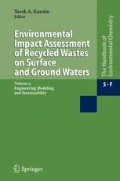Abstract
Potentially hazardous waste materials (HWMs) are increasingly being recycled and used as highway construction and repair materials (CRMs). While reducing disposal costs, this practice raises concerns because hazardous organic pollutants (HOPs) from these wastes can leach from highways and enter soil surface and ground waters. This chapter presents the equilibrium partitioning and mass transfer relationships that control the transport of HOPs between and within highway CRM and different phases in the environment. Partitioning relationships are derived from thermodynamic principles for air, liquid, and solid phases, and they are used to determine the driving force for mass transfer. Mass transfer relationships are developed for both transport within phases, and transport between phases. Some analytical solutions for mass transfer are examined and applied to relevant problems.
Preview
Unable to display preview. Download preview PDF.
Author information
Authors and Affiliations
Corresponding author
Editor information
Rights and permissions
About this chapter
Cite this chapter
Werth, C.J. Equilibrium Partitioning and Mass Transfer of Organic Chemicals Leached from Recycled Hazardous Waste Materials. In: Kassim, T.A. (eds) Water Pollution. The Handbook of Environmental Chemistry, vol 3. Springer, Berlin, Heidelberg. https://doi.org/10.1007/b11493
Download citation
DOI: https://doi.org/10.1007/b11493
Published:
Publisher Name: Springer, Berlin, Heidelberg
Print ISBN: 978-3-540-23585-9
Online ISBN: 978-3-540-28565-6
eBook Packages: Earth and Environmental ScienceEarth and Environmental Science (R0)

